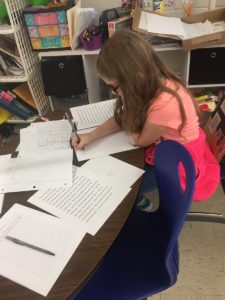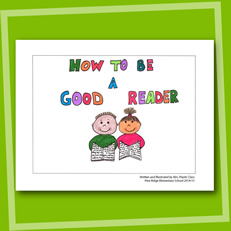 To some 2nd grade students, draft editing is a hard concept to grasp. Some students have trouble identifying their mistakes while others might feel frustrated that there are errors in their work, to begin with. Many students have an attachment to their work as it is a product of their creativity, expression, and imagination. It is important for students to see draft editing as a way to make good writing even better.
To some 2nd grade students, draft editing is a hard concept to grasp. Some students have trouble identifying their mistakes while others might feel frustrated that there are errors in their work, to begin with. Many students have an attachment to their work as it is a product of their creativity, expression, and imagination. It is important for students to see draft editing as a way to make good writing even better.
The Elementary School Writing Process: Understanding the Importance and Purpose of Editing
One of the most overlooked aspects of the American English National Curriculum is draft editing. It is an essential tool for teaching young students about writing fundamentals such as grammar, spelling, punctuation, and capitalization. Many educators find students are more engaged when they create stories using their imagination. Although building creativity is an integral part of learning to write, it is also imperative that students understand the technicalities of creating a coherent story.
Second grade students who are learning to write need to be taught the purpose of editing their work independently. It should be encouraged that editing is not meant to point out mistakes but rather to improve and refine their work.
As much as possible, teachers should only give guidance and feedback when necessary and allow students to edit their own work. Self-editing enables students to learn how to detect and correct their own mistakes. This also allows them to become more independent writers. Self-editing reminds young writers that they are responsible for their work. In contrast, editing your students’ piece on their behalf will not do them any favors later on in their educational career.
The Difference Between Editing and Revising
Many young writers mistake editing for revising, and one of the first things you should do is to explain the difference between the two. The word “editing” might ring major alarm bells because it’s mistakenly perceived to involve rewriting the work and reorganizing ideas.
Students should be made to understand that editing only requires reviewing spelling, grammar, punctuation, capitalization, and sentence structure. Once your students understand the differences, you can then teach them how to effectively edit their work after revisions have been made.
Introduce Common Errors
As mentioned earlier, many students struggle to edit their own work due to an inability to spot self-committed errors.
There are two ways you can introduce common first draft errors to your students.
Have them read their piece aloud then ask them the following questions or use a writer’s checklist:
- Do you have any words that are misspelled?
- Are there certain words that need to be capitalized?
- Is there any punctuation missing from your writing?
Choose a day to discuss common first draft errors. Present your class with a sample draft and demonstrate how to identify and correct common errors. You can make a game out of this by handing out prizes to students that spot errors or - if prizes are not really your thing - you can compliment them on a job well done.
Have Students Take a Break from Their Work
Students will not be able to spot their own errors immediately after finishing their piece of writing. Allow them to take a break so that they can come back and analyze their work with a clearer and fresher mind. Taking a short break also reduces their attachment to the piece, which in turn helps them assess it more objectively.
During their short break, you can have your students do all sorts of activities, like reading a favorite book, playing games with their peers, or starting to think about what type of illustrations they will want to add to their writing.
Find Out What Works for Them
There is really no one-size-fits-all approach to draft editing. Individual students might have their own process of studying and correcting errors. Some might need to make multiple passes – one for spelling, one for grammar, and another one for punctuation. While others might want to just read their work aloud and then complete their edits. Find out what works for each of your students and try to be accommodating to their individual processes.
Are you Enjoying this Content?
Preparing Students for the Next Steps
After self-editing comes writing the second draft and you should prepare students for this next step. Assure your students that writing a new draft is a normal part of the writing process and important to improving their craft.
Have them reflect on their work through a class discussion. During this discussion, your students can share what they like about their piece and what they found difficult – whether that was coming up with a title, writing an introduction, or finding errors. Not only does this help students with their writing, but it also gives you a chance to tailor your feedback and your approach to their specific needs.
Practice Makes Perfect
As with any skill, practice makes perfect. Help your students develop and improve their self-editing skills with free editing and writing worksheets. Our free, printable writing worksheets cover every step of the writing process, from self-editing to making a checklist for the final draft.
PROJECT IDEA
Writing a classbook is popular among teachers and is perfect for students grades Pre K-6 because it gives your class an introduction to the writing process by creating and publishing a physical book.
Have students write down steps that explain how to be a good writer. They can also add an illustration of themselves or the class writing. A classbook about writing is not only something they can treasure for years to come, but they can also use it as a reminder of what they learned about the writing process for the rest of the year, or the next school year. Take a look at the “How to be a Good Reader” classbook above for some inspiration.
Developing the Young Authors of Tomorrow
For more than 25 years, we have been providing free tools for nurturing and developing the authors of tomorrow. Our goal is to inspire every child to find joy in the writing process and build their confidence as creative writers.
We provide free book publishing kits that bring fun, creativity and energy into the classroom. We take care of the teaching resources so you can focus on letting your young writers shine.
At Studentreasures Publishing, we take pride in creating fond memories through writing and student publishing. We want all students to enjoy the writing process and see their hard work come to life in a professionally bound book.







